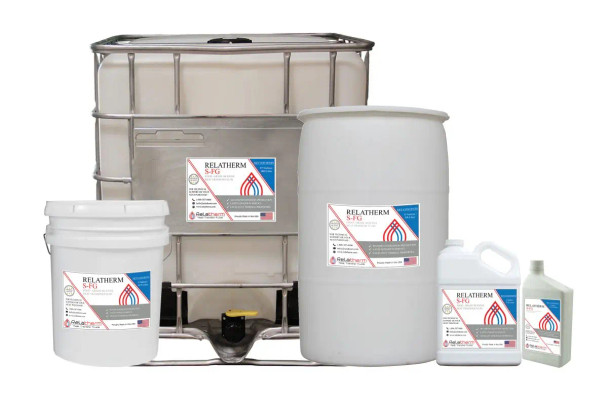Description
RELATHERM S-FG Food-Grade Silicone Heat Transfer Fluid
This premium food-grade engineered thermal fluid is formulated for extreme resistance to fluid degradation. Its premium performance, extended life, and extreme stability in food grade applications makes it an excellent choice in many baths and chillers.
| Maximum Bulk Temp. (Closed System) | 315°C | 600°F |
| Maximum Bulk Temp. (Open System) | 204°C | 400°F |
| Maximum Film Temp. | 365°C | 690°F |
| Pour Point ASTM D97 | -66°C | -87°F |
| Thermal Expansion Coefficient | 0.105 %/°C | 0.055 %/°F |
| Thermal Conductivity | W/m K | BTU/hr F ft |
| -17°C / 0°F | 0.142 | 0.082 |
| 38°C / 100°F | 0.134 | 0.077 |
| 148°C / 300°F | 0.118 | 0.068 |
| 260°C / 500°F | 0.101 | 0.058 |
| 316°C / 600°F | 0.093 | 0.054 |
| Heat Capacity | kJ/kg K | BTU/lb F |
| -17°C / 0°F | 1.611 | 0.385 |
| 38°C / 100°F | 1.714 | 0.410 |
| 148°C / 300°F | 1.921 | 0.461 |
| 260°C / 500°F | 2.137 | 0.512 |
| 316°C / 600°F | 2.246 | 0.537 |
| Flash Point ASTM D92 | 323°C | 615°F |
| Fire Point ASTM D92 | 335°C | 636°F |
| Autoignition ASTM E-659-78 | 436°C | 818°F |
| Viscosity ASTM D445 | ||
| cSt at -51°C / -60°F | 299.88 | |
| cSt at -18°C / 0°F | 113.08 | |
| cSt at 40°C / 104°F | 36.13 | |
| cSt at 149°C / 300°F | 10.57 | |
| cSt at 260°C / 500°F | 5.19 | |
| cSt at 316°C / 600°F | 4.03 | |
| Density ASTM D1298 | kg/m3 | lb/ft3 |
| 38°C / 100°F | 0.9486 | 59.23 |
| 260°C / 500°F | 0.7668 | 47.88 |
| 316°C / 600°F | 0.7209 | 45.01 |
| Vapor Pressure ASTM D2879 | kPa | psi |
| 38°C / 100°F | 0.00 | 0.00 |
| 260°C / 500°F | 1.83 | 0.26 |
| 316°C / 600°F | 7.21 | 0.99 |
| Distillation Range ASTM D2887 | 10% | 494°C (922°F) |
| 90% | 679°C (1255°F) |
WHY RELATHERM S-FG?
Relatherm was one of the first few thermal fluid suppliers to introduce a food-grade silicone heat transfer fluids in the industry. Relatherm S-FG is manufactured from a blend of high purity Silicone fluids and proprietary additives that ensure that sludge formation and coke deposition do not occur. Relatherm S-FG is thermally stable, even at elevated temperatures. In comparison with other industry fluids, it provides for an oxidation-free, less odorous, safer, cleaner, and trouble-free operation.
EXTENDED FLUID LIFE
Relatherm S-FG is often selected for its durability and oxidative-stability in typically problematic systems such as open baths. Its base chemistry is non-susceptible to oxidation. As such, Relatherm S-FG has a service life much longer than most thermal fluids in exposed systems.
NO OXIDATION! NO GUNK!!
Relatherm S-FG is fully resistant to oxidation in open and non-airtight systems. By virtue of its uniquely stable chemistry, it is non-susceptible to oxidative reaction mechanisms. This translates into the absence of sludge and carbon deposits. When used within the specified operating range, Relatherm S-FG provides lower maintenance costs, longer uptime and less frequent fluid changeouts.
HEALTH, SAFETY & THE ENVIRONMENT
Relatherm S-FG is non-toxic and non-hazardous. It is environmentally friendly and poses no adverse effect to personnel safety. There are no special handling procedures for fluid disposal. After its long-service life, it can be disposed with other waste oils/lubricants in accordance with applicable statutes.
COMPREHENSIVE PRODUCT PORTFOLIO
If Relatherm S-FG does not meet your application requirements, there is a very good chance that we will be able to offer a better suited solution from our comprehensive portfolio of thermal fluids and system cleaners. Contact us to discuss your application with a Thermal Fluids Expert.
PRODUCT SUMMARY
- Oxidation-proof thermal fluid great for open baths and other aerated systems
- NSF registered – Meets FDA requirements for incidental food contact (HT-1) as per 21CFR178.3570
- Maximum use temperature: 315ºC / 600°F in closed systems and 204ºC / 400°F*
- Great chiller/cooling fluid down to -51°C (-60°F)
- Non-toxic and non-hazardous thermal fluid
*In open systems operating above 204ºC / 400°F, gel formation is known to occur due to a polymerization reaction. As such, for open systems, the operating temperature should not exceed the recommended maximum use temperature.





